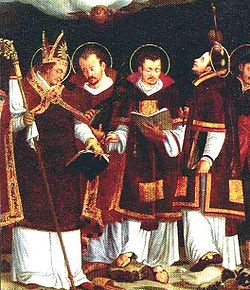Vigilius of Trent
| Saint Vigilius of Trent | |
|---|---|

Saint Virgilius, and martyrs Sisinnius, Martyrius and Alexander. Paolo Naurizio, 1583.
|
|
| Bishop and martyr | |
| Born | ~353 possibly Trento |
| Died | 26 June, 405 near Lake Garda in the Val di Rendena |
| Venerated in | Roman Catholic Church |
| Major shrine | Trent |
| Feast | 26 June |
| Attributes | bishop holding a shoe; wooden clogs (Holzschuh) |
| Patronage | Trento; Tyrol; mining and mines; Diocese of Bolzano |
Saint Vigilius of Trent (Italian: San Vigilio di Trento) is venerated as the patron saint and first bishop of Trent. He should not be confused with the pope of the same name. According to tradition, he was a Roman patrician and was the son of Maxentia and a man whose name is sometimes given as Theodosius.
His brothers, Claudian and Magorian, are also venerated as saints. Vigilius was educated at Athens and seems to have been a friend of Saint John Chrysostom.
He then went to Rome and then settled at Trento in 380 and was chosen to be bishop of that city. He may have been consecrated by either Ambrose of Milan or Valerian of Aquileia (Valerianus). As bishop, Vigilius attempted to convert Arians and pagans to orthodox Christianity and is said to have founded thirty parishes in his diocese. The founding of the Church of Santa Maria Maggiore, Trento is traditionally attributed to him. A letter attributed to Ambrose has the Milanese bishop encouraging Vigilius to oppose marriages between Christians and pagans (Ep. 29 in P.L., XVI, 982). Vigilius preached in Brescia and Verona, which lay outside of his diocese.
His companions during his missions were Saints Sisinnius, Martyrius and Alexander, who were sent by Ambrose to assist Vigilius. Tradition makes these three natives of Cappadocia. A work called De Martyrio SS. Sisinnii, Martyrii et Alexandri (P.L., XIII, 549) is attributed to Vigilius.
Sisinnius, Martyrius and Alexander (Sisinio, Martirio e Alessandro) were killed at Sanzeno after they attempted to convert the local population there to Christianity; Vigilius forgave their killers and had the remains of the three men sent to John Chrysostom in Constantinople, as well to Simplician, Ambrose's successor, in Milan. Milan would later give some of those relics back to Sanzeno in the 20th century, where they rest in the Basilica dei Ss. Martiri dell'Anaunia.
...
Wikipedia
